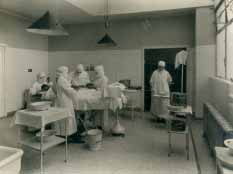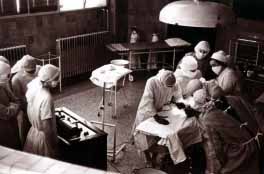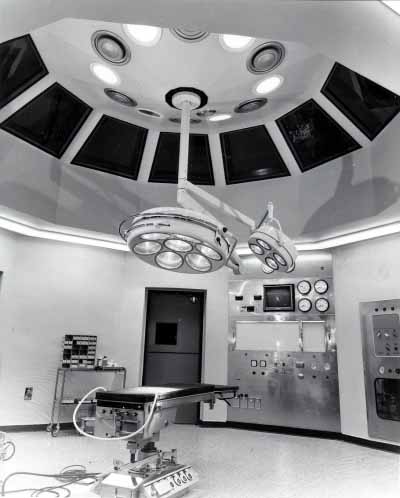Operating Theatre Design

Photograph from the DRI Annual Report 1909 (Tayside Medical History Museum)
The design of operation rooms and their ancillary spaces has responded over the years to changes in surgical needs and practice. The advent of anaesthesia led to the provision of rooms for both induction of and recovery from the anaesthetic, and the promotion of antisepsis led to better design of theatres, equipment and clothing with the aim of eliminating infection. All contents of the theatre were therefore made of materials that were easily washable, all angles were rounded, window frames were flush with the inner surface of walls, instruments with bone handles gave way to solid forged tools, and surgeons replaced frock coats with theatre gowns, washed their hands before operating and wore gloves and masks.


Left: Operating in Arbroath Infirmary, 1910 (Courtesy of Dundee City Archives)
Right: Operating in Caird Block at DRI, 1930s (Courtesy of Tom King)
In the days before Ninewells, surgical instruments had to be sterilised in an autoclave in theatre and hand-picked by the nurse-in-charge of the operation - the choice of instruments was partly dependent on which surgeon was doing the operation. The opening of Ninewells brought in standardised packs for each operation, although because TSSU (the Theatre Sterile Services Unit) was within the theatre complex, any instruments dropped on the floor could be quickly re-sterilised. This is not now possible with a distant Central Sterile Services facility.
When Ninewells Hospital was being designed some 50 years ago, Sir Donald Douglas was then the Professor of Surgery. His experience in the War working in tented theatres had made him sceptical that the structure of a theatre had much to do with hospital infection, but that "people and not things are the main source of wound infections". Unremitting personal surgical discipline was his mantra, although he did qualify this with these suggestions:
- Segregate septic cases (in infectious diseases hospitals)
- Exclude unnecessary people (students and technicians) from the theatre
- Construct a clear physical barrier to exclude all ward linen and equipment
- Clearly demarcate the theatre suite into clean, sterile, and disposal zones
- Provide effective theatre changing facilities and theatre clothing
- Avoid long operating lists, ideally limiting to three operations per session

A valuable and unusual part of the design process was the building of full-scale mock-ups, which allowed some modification in planning, lighting, ventilation and acoustics. Professor Douglas is seen here at a 'mock operation'. (Courtesy of NHS Tayside)
Rooms in which operations are performed are still called theatres in the UK. Ninewells was one of a few hospitals built in the 1960s with viewing galleries for the medical students and technical staff, but they were little used by the students and extra staff were required to make any adjustments to the apparatus. Technical staff are now back in the theatre as an essential part of the modern operating team and the viewing galleries have been boarded up.

Operating theatre in Ninewells, 1974 (Tayside Medical History Museum)